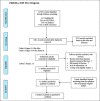Anaemia Is Associated with an Increased Risk of Fractures, a Systematic Review, and Meta-Analysis
- PMID: 35314584
- PMCID: PMC9808740
- DOI: 10.1159/000522591
Anaemia Is Associated with an Increased Risk of Fractures, a Systematic Review, and Meta-Analysis
Abstract
Background: Anaemia and osteoporotic fractures are both major health problems among older adults worldwide.
Objectives: Previous studies suggest that anaemia may be associated with elevated fracture risk among older adults; however, the exact relationship between them is unknown. We aimed to investigate the association between anaemia and fracture risk.
Methods: A comprehensive literature search was performed in four medical databases. We included articles that were published from inception to February 18, 2021. Odds ratios (ORs), hazard ratios (HRs) with 95% confidence intervals (CIs), and original raw incidences from studies comparing fracture rates in anaemic versus non-anaemic patients were extracted and pooled with the random-effects model. I2 test was used to assess heterogeneity. Risk of bias assessment was performed using the Quality of Prognostic Studies tool.
Prospero: CRD42021241109.
Results: A total of 13 studies were identified; 8 of them were included in the quantitative synthesis. Anaemia was found to be a risk factor for fracture compared to non-anaemia. Anaemia increased hip fracture risk in both older men (HR = 1.71; CI: 1.46-2.00, p< 0.001, I2 = 83.2%) and women (HR = 1.31; CI: 1.13-1.52, p< 0.001), but the fracture risk was more increased among men. There was also an increased chance of hip fracture in the presence of anaemia in populations, including both older men and women (OR = 1.64; CI: 1.35-2.01, p< 0.001, I2 = 61.1%). Anaemia was also associated with increased vertebral (HR = 1.21; CI: 1.04-1.40, p = 0.012) and all-type (HR = 1.49; CI: 1.19-1.86, p< 0.001) fracture risk in older men.
Conclusion: Our results suggest that there is a significant relationship between anaemia and fracture risk in older adults. This association is stronger among older men than women and differs in the different types of fractures.
Keywords: Anaemia; Bone; Fracture risk; Older adults.
© 2022 The Author(s). Published by S. Karger AG, Basel.
Conflict of interest statement
The authors have no conflicts of interest to declare.
Figures









References
-
- Mathers CD, Stevens GA, Boerma T, White RA, Tobias MI. Causes of international increases in older age life expectancy. Lancet. 2015;385((9967)):540–548. - PubMed
-
- McLean E, Cogswell M, Egli I, Wojdyla D, de Benoist B. Worldwide prevalence of anaemia, WHO vitamin and mineral nutrition information system, 1993–2005. Public Health Nutr. 2009;12((4)):444–454. - PubMed
-
- Lanier JB, Park JJ, Callahan RC. Anemia in older adults. Am Fam Physician. 2018;98((7)):437–442. - PubMed
-
- Lane NE. Epidemiology, etiology, and diagnosis of osteoporosis. Am J Obstet Gynecol. 2006;194((2 Suppl)):S3–11. - PubMed
Publication types
MeSH terms
LinkOut - more resources
Full Text Sources
Medical

